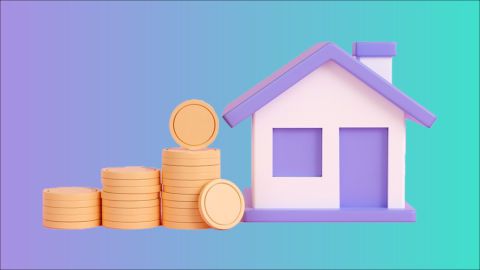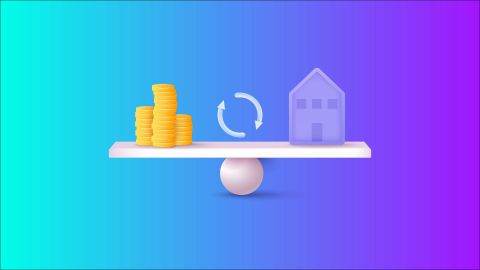What is GST on flat purchase?
GST, or Goods and Services Tax, is like a tax added to the cost of things you buy or services you use in India. When you buy a new or under-construction home, you might need to pay GST on it. The amount of GST you pay depends on factors like the type of property, where it is, and whether it is ready to move in or still being built.
Calculating GST on flat purchase involves looking at the property's market value. But there are many factors that can affect how much GST you pay, like the type of property, where it is, and if it is under construction. Government rules can also change, so it is a good idea to talk to a tax expert or a real estate agent to understand exactly what charges you might have to pay. GST is only for under-construction properties. So, if you are buying a house that is already built and ready to move in, you usually will not have to pay GST.
When it comes to calculating GST on flat purchase, it is a bit different from under-construction properties. Input Tax Credit (ITC) is an important part of the GST system. It is like a discount that you can get if you have the right documents, like a tax invoice.
Depending on the kind of property, the GST rate might change. For under-construction affordable housing, it is usually 1% without ITC. For luxury flats (non-affordable housing), it is 5% without ITC. And if you are thinking of getting a ready-to-move new flat, you usually will not have to pay any GST. There is also no GST on buying land.
Keep in mind that GST rates can change, so it is smart to get advice from a pro when you are buying a property in India. They can help you understand all the ins and outs of GST and how it might affect your purchase.
What are the GST rates on property purchase?
Initially, the GST rates for property purchases were set at 12% for non-affordable housing and 8% for affordable housing. However, following the 33rd GST Council meeting, revised rates came into effect on April 1, 2019. Under the new structure, affordable housing is taxed at 1%, while non-affordable or luxury housing attracts a GST rate of 5%, both without the benefit of Input Tax Credit (ITC).
GST on under-construction properties
Tax structure:
Under-construction properties are subject to GST, and the tax is applicable to the construction value and not the entire property value. Currently, the GST rate for real estate is 5% without Input Tax Credit (ITC) for residential properties and 1% for affordable housing projects.Impact on developers:
Developers are required to pay GST on the sale of under-construction properties. The cost may be passed on to the homebuyer, affecting the overall property cost.Input Tax Credit (ITC):
Initially, developers were allowed to claim ITC on inputs like raw materials and services. However, as of April 1, 2019, ITC is not applicable to developers for residential projects.
GST on ready-to-move-in flats
Exemption for completed properties:
Properties that have received a completion certificate are exempt from GST. Buyers of ready-to-move-in flats do not need to pay GST on the property purchase.Maintenance charges:
While GST is not levied on the property cost, homebuyers may be subject to GST on maintenance charges if the builder provides maintenance services after possession.
How to calculate of GST on flat purchase
Let’s say you are buying a flat worth Rs. 50,00,000 in a non-affordable housing project. Here’s how you calculate the GST:
- Total Cost Before GST: Rs. 50,00,000
- GST Rate: 5%
- GST Amount: Rs. 50,00,000 × 5% = Rs. 2,50,000
- Final Price: Rs. 50,00,000 + Rs. 2,50,000 = Rs. 52,50,000
What is Input Tax Credit (ITC) in GST?
Input Tax Credit (ITC) in GST refers to a mechanism that allows businesses to reduce the tax they have already paid on their inputs (goods or services purchased for business purposes) from the tax they owe on their outputs (goods or services sold). Essentially, it helps avoid the cascading effect of taxes, ensuring that tax is levied only on the value added at each stage of the supply chain.
Types of state and central taxes replaced by GST on flat purchase
When GST was implemented in July 2017, it replaced various central and state taxes, including the following:
Central taxes:
- Customs duty
- Excise duty
- Service tax
- Central sales tax
- Special additional duty of customs
- Central surcharges and cesses on the supply of goods and services
State taxes:
- Luxury tax
- Purchase tax
- State excise duty
- Advertisement tax
- Entertainment tax
- State Value Added Tax (VAT)
- Taxes on lotteries, gambling, and betting
- State surcharges and cesses on the supply of goods and services
This unified tax structure simplified the indirect taxation system in India, fostering ease of compliance and reducing the cascading effect of multiple taxes.
Benefits of paying GST on flat purchase
- Transparency: GST ensures transparency in the property transaction process.
- Standardisation: It standardises the tax rate across the country, making it easier to understand.
- Reduced tax burden: GST replaces multiple indirect taxes, potentially lowering the overall tax burden.
Impact of GST on home buyers
Home buyers are directly affected by GST, influencing the overall cost of acquiring a property. Understanding the GST implications allows buyers to make informed decisions and plan their finances accordingly.
The impact of Goods and Services Tax (GST) on home buyers influences various aspects of the real estate transaction. Here is a breakdown of how GST affects home buyers:
- Cost of property
GST is applicable to under-construction properties, adding an extra cost to the overall property price. Home buyers need to consider this additional expense when budgeting for their property purchase. - Financial planning
Home buyers financing their purchase through loans should account for the GST component, as it affects the total loan amount and, consequently, the Equated Monthly Instalments (EMIs). - Choice of property type
The impact of GST may influence the type of property a buyer chooses. Ready-to-move-in properties generally do not attract GST, making them a potential preference for those looking to avoid this tax. - Developer compliance
Developers are responsible for collecting and remitting GST to the government. Home buyers should ensure that the developer complies with GST regulations to avoid any legal or financial implications. - Transaction transparency
Understanding the GST implications adds transparency to the real estate transaction. Home buyers are better informed about the total cost involved in the property purchase. - GST rates and calculations
Home buyers need to be aware of the applicable GST rates and how they are calculated. This includes considering factors such as the type of property, construction status, and Input Tax Credit (ITC) availability. - Ready-to-move vs. Under-construction
The choice between a ready-to-move-in property and an under-construction one is influenced by GST. Ready-to-move-in properties generally do not attract GST, making them potentially more attractive to certain buyers. - Potential savings through ITC
For under-construction properties, understanding the Input Tax Credit (ITC) is crucial. Proper documentation, like a tax invoice, allows buyers to potentially claim ITC and reduce the effective GST burden. - Government policies and regulations
The impact of GST on home buyers may vary based on changes in government policies and regulations. Staying informed about any updates is essential for accurate financial planning. - Professional guidance
Seeking advice from tax consultants or real estate experts helps home buyers navigate the complexities of GST. Professionals can provide tailored guidance based on individual property transactions.
Impact of GST on Home Loan
The inclusion of GST in the overall cost of the property affects the loan amount that home buyers may need. This, in turn, impacts the Equated Monthly Instalments (EMIs) and the financial dynamics of home loan repayments.
The impact of Goods and Services Tax (GST) on home loans is primarily associated with the cost implications for home buyers. Here is how GST affects home loans:
- Increased cost of property
GST is applicable to under-construction properties, and the amount is calculated as a percentage of the total property cost. This means that the overall cost of the property, including the GST component, is higher for home buyers. - Impact on loan amount
Since GST increases the overall cost of the property, home buyers financing their purchase through home loans may need to borrow a larger amount. This, in turn, affects the Equated Monthly Instalments (EMIs) and the financial dynamics of loan repayments. - Developer compliance
Developers are responsible for collecting and remitting GST to the government. Home buyers relying on home loans should ensure that the developer complies with GST regulations to avoid any legal or financial complications. - GST rates and loan calculations
Understanding the applicable GST rates and how they are calculated is crucial for home buyers using home loans. Different rates may apply based on factors like the type of property, construction status, and availability of Input Tax Credit (ITC). - Potential savings through ITC
For under-construction properties, home buyers may be eligible for Input Tax Credit (ITC) if proper documentation, such as a tax invoice, is available. This can potentially reduce the effective GST burden and contribute to cost savings. - Impact on loan repayment period
The increased loan amount due to GST can affect the length of the loan repayment period. Home buyers may need to evaluate and adjust the loan tenure based on their financial capacity. - Interest on GST amount
In some cases, the GST amount may be treated as part of the overall loan amount, attracting additional interest charges over the loan tenure.




